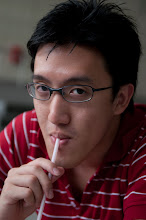Initially Timothy told me the White Raffles Statue should be quite near to a museum nearby.. and we headed there as our first stops:
Singapore Arts Museum
 Unfortunately, the white raffles was not there... but then we discovered there is another one standing on top at the front of the entrance. According to Timothy, he also got the same statue standing in his old secondary school.. St. Patrick School @ 490 East Coast Road.
Unfortunately, the white raffles was not there... but then we discovered there is another one standing on top at the front of the entrance. According to Timothy, he also got the same statue standing in his old secondary school.. St. Patrick School @ 490 East Coast Road.That statue was the founder of St. John Baptist De Lasalle. There was a long descriptions from the following website: http://www.newadvent.org/cathen/08444a.htm and it is all about catholic religion... ^_^ Happy reading if you are interested..
The Arts House
Timothy recalled that his photography kakis took the White Raffles before and called to check with him... that guy guided us to North Bridge Road.. which is walking distances from where we are... so we slowing stroll towards that direction and Timothy took some pics of other historical buildings along the way.

And finally... here is the famous White Raffles Statue standing proudly along the Singapore river.. i think that was the same background if i can recall looking at it on the history textbook i have learnt during primary school.. all the while i was wondering where the hell it is.. and now it stands right in front of me... and Timothy took it with the SingTel buildings behind... I also didnt know there is a SingTel building there.. i tot it was a fake one from the F1 posters i saw when SingTel advertised as the sponsorer for the F1 GP...
Asian Civilisation Museum
We continued our shooting spree on the statues and shot quite a few along the side of the Singapore River when we head down towards the Victoria Theatrette to shoot the black Raffles Statue. We saw 2 sets of human statues along the way, and these 2 sets of human statues was actually a sculptor from different person:

The first one is sculpted by Malcolm Koh and it is a community project sponsored by ExonMobil. There is also a encrypted stone beside it saying these:
"Sir Stamford and Raffles wrote in 1819, 'Our object is not territory but trade, a great commercial emporium'. At the heart of the settlement's trade was the Singapore River. Lighter craft crowded the banks of the River along Boat Quay, and merchants had offices and godowns either here or a Commercial Square (Raffles Place). Early trade was in silk, cotten, spices and other exotic commodities, in the late 19th century, this shifted to rubber, tin and copra. European traders, like those here, profited from Singapore's trade but it was the Chinese traders, like the towkay holding an abacus, who generated the most wealth.
Providing much needed labour to the trading industry were Chinese and Indian coolies. Chinese coolies came from southeaster provinces of China, while Indian coolies hailed from South India. The Chinese coolie and towkay in this sculpture are identified by their queue, or pigtailm which the Qing authorities required all Chinese then to wear. When the Qing dynasty ended in 1912, queues where done away with. The Indian coolie wears the customary turbans. Life as a coolie was difficult. Coolies lived in cramped and squalid conditions, often with no proper ventilation or sanitation. Many a coolie ended his days in Singapore, alone and penniless, plying the trading boats that crowded the Singapore River.
Growing hand in hand with trade was the finance industry. The sculpture to the right encapsulates the dramatic changes that the finance industry has undergone from traditional moneylenders to today's stock market dealers."

The other was sculpted by Chern Lian Shan, also with a stone board crafted these words:
"Singapore's position as a centre for entrepot trade led to the proliferation of financial institutions. The settlement's first bank was the Bank of Calcutta, established in 1840. Financial businesses set up their offices near the Singapore River to be close to the area's many trading houses.
Early services were divided along ethnic lines. The moneylending business in the early days was primarily run by the Chettiars who came from South India. The Chettiars congregated at Market and Chulia Streets, and their offices were easy to spot. These usually comprised a clerk and a manager who sat behind a small low desk on a woven mat, as shown here. Clearing houses were the domain of the Chinese. Capitalising on abundant trade between Singapore and China, these companies thrived. Clerks, like this standing pig-tailed man, were a common sight as they bustled to and from offices in Commercial Square (Raffles Place).
Today, major local and multinational financial institutions provide a wealth of sophisticated financial services. On the trading floor of the Singapore Exchange almost everyday are hundreds of traders, whose distinctive jackets have become the symbol of economic growth. This tableau's lady trader hails the knowledge driven future, symbolised by the Millennium figure who leads the way into the Asian Civilisation Museum."
Phew!!~ enough of all the history of Singapore... there is also another two human statues along the track to the Victoria Theatrette, the statues potray the Warrior Official and the Civil Official during the several Dynasty in China.


Victoria Theatrette
Finally we have reached the theatre and took a few shots on the black Raffles... this is the replica of the white Raffles previously at the North Bridge Road... and that is the one i know... ^_^


Enough of that half a day being a tourist of Singapore... hopefully I may still find more human statues to display for my blog... i think there are still a few in Mt Faber... Labrador Park.. etc... Tune in for more HUMAN Statues of Singapore!!!~

No comments:
Post a Comment